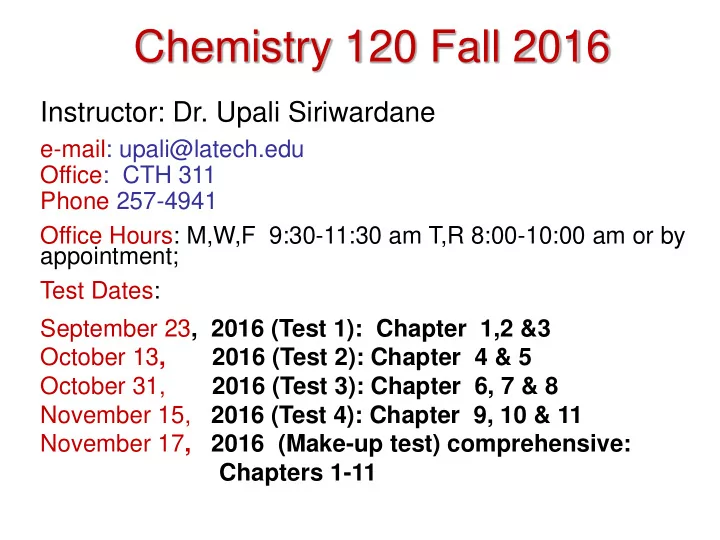

Chemistry 120 Fall 2016 Instructor: Dr. Upali Siriwardane e-mail: upali@latech.edu Office: CTH 311 Phone 257-4941 Office Hours: M,W,F 9:30-11:30 am T,R 8:00-10:00 am or by appointment; Test Dates: September 23 , 2016 (Test 1): Chapter 1,2 &3 October 13 , 2016 (Test 2): Chapter 4 & 5 October 31, 2016 (Test 3): Chapter 6, 7 & 8 November 15, 2016 (Test 4): Chapter 9, 10 & 11 November 17 , 2016 (Make-up test) comprehensive: Chapters 1-11
Chapter 3. Atomic Structure and the Periodic Table 3-1 Internal Structure of an Atom Arrangement of Subatomic Particles Within an Atom Charge Neutrality of an Atom Size Relationships Within an Atom 3-2 Atomic Number and Mass Number Electrons and Chemical Properties 3-3 Isotopes and Atomic Masses Isotopes Atomic Masses 3-4 The Periodic Law and the Periodic Table Groups and Periods of Elements The Shape of the Periodic Table 3-5 Metals and Nonmetals Periodic Table Locations for Metals and Nonmetals 3-6 Electron Arrangements Within Atoms Electron Shells Electron Subshells Electron Orbitals Electron Spin
Chapter 3. Atomic Structure and the Periodic Table 3-7 Electron Configurations and Orbital Diagrams Subshell Energy Order Writing Electron Configurations and Orbital Diagrams 3-8 The Electronic Basis for the Periodic Law and the Periodic Table Electron Configurations and the Periodic Law Electron Configurations and the Periodic Table 3-9 Classification of the Elements
What’s covered in this chapter? • Structure of an atom • Atomic number and mass number • Isotopes and (average) atomic masses • Periodic table • How are electrons arranged in atoms? • How to describe electron arrangements for each element • Metals, non -metals, and metalloids
Atoms • What are atoms? – Chapter 1: the smallest particle of an element that can exist and retain all of the properties of the element
The Nuclear Atom • The current model of the atom predicts a very small, dense nucleus with the electrons around the outside of the atom. • Most of the volume of the atom is empty space.
Atomic Structure
Subatomic Particles Atoms are made of three types of subatomic particles: protons, electrons, and neutrons. • Protons (+) and electrons (-) are the only particles that have a charge. • Protons and neutrons are found in the nucleus (core); electrons reside outside of the nucleus. Thus protons and neutrons are sometimes called “ nucleons ”
Subatomic Particles Atoms are made of three types of subatomic particles: protons, electrons, and neutrons. • Protons (+) and electrons (-) are the only particles that have a charge. • Protons and neutrons are found in the nucleus (core); electrons reside outside of the nucleus. Thus protons and neutrons are sometimes called “ nucleons ”
Symbols of Elements An element’s symbol gives information about the number of protons, neutrons, and electrons in an atom or ion Q: What distinguishes atoms of one element from those of another element?
Atomic Number All atoms (and as we’ll see later, ions) of the same element have the same number of protons. The atomic number (Z) represents the number of protons in the nucleus of an atom of some element.
Mass Number The mass of an atom in atomic mass units (amu) is the sum of the number of protons and neutrons (i.e. total number of nucleons) in the atom. The mass number for an element is given the symbol, “A” An element’s atomic number and mass number can be found in the periodic table
Recommend
More recommend